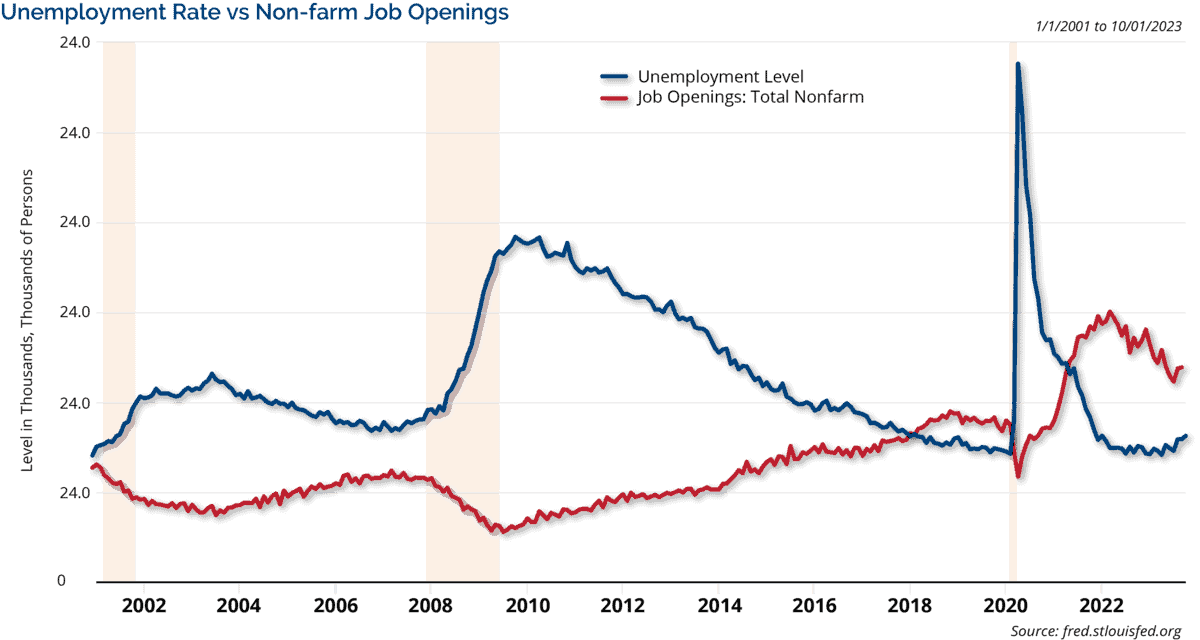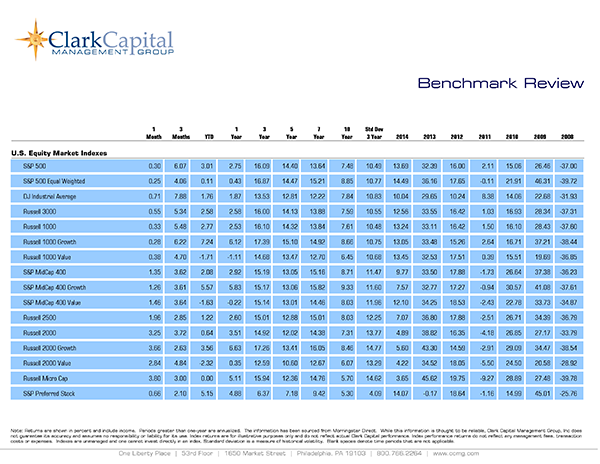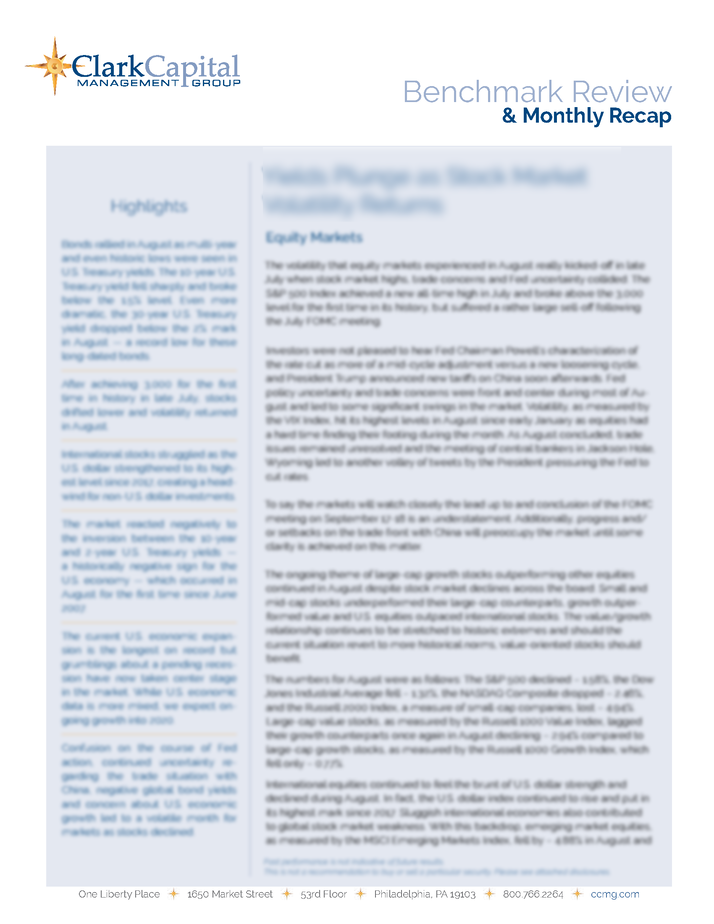Stocks Slip Further in October as Yields Continue to Press Higher
HIGHLIGHTS:
- The first month of the fourth quarter started on a down note as recent equity weakness continued. Stocks dropped for the third straight month in October.
- The VIX Index, a measure of stock market volatility, moved to its highest level since March during the month, hitting 22 on an intraday basis. It closed October at just over 18.
- The FOMC concluded a meeting on November 1 and as expected, it left policy rates unchanged. Monetary conditions have tightened as rates have moved higher in the market and the Fed was able to pause at this meeting.
- The increase in yields put pressure on bond returns in October. The yield on the 10-year U.S. Treasury hit 5% intraday for the first time since 2007 and bond returns continued to struggle in October. The 10-year closed October at 4.88% after ending September at 4.59%.
- The economy remained resilient. The first reading of Q3 GDP was reported late in October and came in at a 4.9% annualized growth rate. Hiring activity was also strong during the month as rate hikes have yet to cause significant weakness in the job market.
- Also on a positive note, corporate earnings are improving, and earnings are expected to grow in calendar years 2023 and 2024.
EQUITY MARKETS
The strong early summer for stocks gave way to late-summer weakness, and that weakness continued into the fall. For the third straight month, broad equity indices moved lower. Declines were widespread, but small-caps came under particular pressure and in the large-cap space, value had larger declines than growth. International stocks fell as well. See Table 1 for equity results for October and YTD.
Table 1
| Index | October 2023 | YTD |
|---|---|---|
| S&P 500 | -2.10% | 10.69% |
| S&P 500 Equal Weight | -4.08% | -2.36% |
| DJIA | -1.26% | 1.44% |
| Russell 3000 | -2.65% | 9.41% |
| NASDAQ Comp. | -2.76% | 23.61% |
| Russell 2000 | -6.82% | -4.45% |
| MSCI ACWI ex U.S. | -4.13% | 0.99% |
| MSCI Emerging Mkts Net | -3.89% | -2.14% |
As the table shows, declines in October pushed the S&P 500 Equal Weight Index, the Russell 2000 Index, and the MSCI Emerging Markets Index into negative territory on a year-to-date basis. Comparing and contrasting the S&P 500 Index with its equal-weighted counterpart provides important insight into this market.
Driven by the strong performance of mega-cap Technology companies, the S&P 500 Index showed a solid year-to-date gain of over 10.6%. However, the equal-weighted S&P 500 Index (which can be thought of as representing what the average stock is doing) has now turned negative on the year, down over -2.3%. Simply said, the largest cap Technology companies, which have a larger weighting in the S&P 500 Index, have been the primary drivers of this narrow market in 2023. Meanwhile, the average stock has struggled.
Contrasting with large companies, small-caps, as measured by the Russell 2000 Index, had one of the weakest months of the equity indices in October, which pushed this index into the worst position in Table 1 year to date. Meanwhile, the large-cap focused Russell 1000 Index has gained 10.28% year to date, with the growth version of this index up 23.20%, and the value version down -1.80%. Large-cap growth has dominated this year, while value and small-caps have been weaker.
Broad international equities were somewhat weaker than U.S. markets in October. The MSCI ACWI ex. U.S. Index was down -4.13% in October and the MSCI Emerging Market Index fell -3.89%. Broad international markets were able to hold on to positive results so far this year through October (just barely), while emerging markets are now negative overall.
We still see opportunities in international markets with valuations that are significantly lower than the U.S. and our expectation that the U.S. dollar will largely weaken over the short to intermediate term.
Fixed Income
As rates continued to rise in October, bond returns continued to struggle. With the exception of high-yield bonds, the other bond indices are all now in the red year to date. The 10-year U.S. Treasury yield has been trending upwards since late spring and it made another push higher in October. It closed September at 4.59% and rose to end October at 4.88% after hitting 5% on an intraday basis during the month – the first time that level has been achieved since 2007. Rates have been volatile in 2023, but the trend has been higher in recent months. See Table 2 for fixed income index returns for October and year to date.
Table 2
| Index | October 2023 | YTD |
|---|---|---|
| Bloomberg U.S. Agg | -1.58% | -2.77% |
| Bloomberg U.S. Credit | -1.78% | -1.75% |
| Bloomberg U.S. High Yld | -1.16% | 4.63% |
| Bloomberg Muni | -0.85% | -2.22% |
| Bloomberg 30-year U.S. TSY | -5.38% | -14.54% |
| Bloomberg U.S. TSY | -1.21% | -2.71% |
We believe the recent move higher in rates has presented bond investors with opportunities to invest at even higher yields and coupons than seen earlier this year. We certainly acknowledge that the accompanying near-term decline in bond prices has been a challenge but higher yields in bond portfolios could benefit clients over the longer term. We expect the 10-year U.S. Treasury yield to move lower as we go through 2023 and into 2024, but we also anticipate volatility along the way. The more interest rate sensitive pockets of the bond market (like U.S. Treasuries) have been the hardest hit by rising rates, but most bond sectors outside of high yield have succumbed to the move higher in rates so far this year.
We maintain our long-standing position favoring credit versus pure rate exposure in this interest rate environment. We also believe the role bonds play in a portfolio, to provide stable cash flow and to help offset the volatility of stocks in the long run, has not changed. Furthermore, we believe that bond yields are attractive in what are some of the highest yields we have seen in the last 15 years.
Economic Data and Outlook
The economy continued to show expansion in September (based on data released in October) and closed out the strongest quarter of growth since the 4th quarter of 2021. Although this might pose a challenge to the Fed as it tries to slow inflation, the economy has been resilient despite the aggressive rate hike cycle that began March 2022.
Job market progress has been particularly strong in recent months. Non-farm payroll additions were almost double expectations in September – a 170,000 estimate compared to a reported 336,000 additions. Furthermore, the prior month data was revised higher to show 40,000 more hires compared to the initial report. The unemployment rate stayed at 3.8% in September, however a slight drop to 3.7% was expected. Average hourly earnings fell modestly to 4.2% from the prior reading and estimates of 4.3%. Job openings increased again in September to 9.553 million, easily surpassing expectations of 9.4 million. Job openings remain plentiful, but they are down from their peak levels. The aggressive rate hikes by the Fed might be having a modest impact on hiring decisions as job openings have trended lower. However, the labor market remains strong with millions more job openings compared to unemployed people. Chart 1 shows this relationship between job openings and unemployed people.
Chart 1
We maintain our opinion that it seems unlikely that the economy would not slow too drastically with the current strength exhibited in the labor market. However, even a modest slowdown in the job market could be a headwind to economic activity due to the central role that consumer spending plays in the U.S. economy. The odds of a soft landing have likely increased in recent months, particularly with the recent GDP report, but a reasonable probability of a mild recession still exists and should not be dismissed. We believe opportunities exist in the market under either of these two scenarios as consumers remain strong and the job market remains healthy.
The headline Consumer Price Index showed an annual increase of 3.7% in September, which matched August, but was a slight miss of expectations of 3.6%. The core CPI increased by 4.1% in September on an annual basis as expected and this was an improvement from August’s 4.3% gain. The headline Producer Price Index was higher than expected at 2.2% annual gain compared to expectations of 1.6%. The core PPI had an annual increase of 2.7% in September, exceeding estimates of 2.3%. The Producer Price Index is generally seen as a leading indicator for inflation since these costs occur during the production part of the cycle before products are sold to consumers.
Focusing on the preferred inflation measure of the Federal Reserve, the Personal Consumption Expenditures (PCE) Index showed a 3.4% annual gain in September, matching expectations and August’s revised level. The core PCE reading (the reading the Fed targets) was 3.7%, also in-line with expectations and a modest improvement from the August reading of 3.8%. Chart 2 shows the headline and the core readings of the Personal Consumption Expenditures Index.
Chart 2
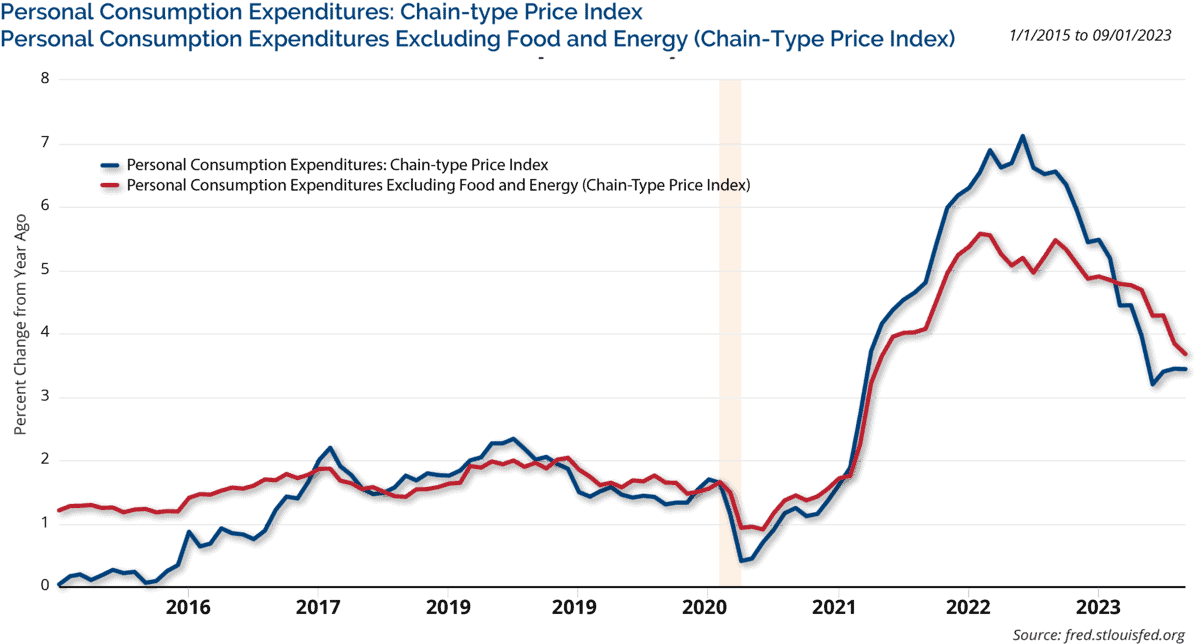 For illustrative purposes only. For illustrative purposes only. Past performance is not indicative of future results.
For illustrative purposes only. For illustrative purposes only. Past performance is not indicative of future results.Some volatility in inflation readings is not unexpected as the high-water marks from the summer of 2022 have fallen off the measures and prior year comparisons become more difficult. The key question is whether the pace of improvement is good enough for the Fed or whether it might try to bring down inflation more rapidly to its long-term goal of about 2% with additional rate hikes. Clearly, progress has been made on the inflation front, but we are also still above the 2% goal. This is something Fed Chairman Powell continues to reiterate. As general interest rates rose during October, Fed officials acknowledged that these higher rates had tightened monetary conditions further and gave them cover to keep rates unchanged at the November FOMC meeting.
Housing data was somewhat mixed last month; however, mortgage rates surged toward 8% in October, which will likely cool housing activity in the months ahead. In September, building permits, considered a leading indicator for housing, were at an annualized pace of 1.473 million – above expectations of 1.453 million, but a drop from the August level of 1.541 million. Housing starts missed expectations (1.383 million estimate versus 1.358 million reported), but this was a solid increase from the 1.269 million pace from August. Existing home sales slipped below the 4 million annual rate level in September to 3.96 million, but that was better than expectations of 3.89 million. New home sales at a 759,000 annual pace in September easily surpassed estimates of 680,000 and the prior month of 676,000. Home prices rose in August by 2.16%, which was modestly better than expectations of a 1.75% increase based on the S&P CoreLogic 20-City Index. As previously mentioned, mortgage rates took another leg higher in October and stand at multi-year highs. Chart 3 shows higher mortgage rates and building permits. It will be important to see if this latest move higher in mortgage rates cools housing activity and whether building permits take another leg lower because of high mortgage costs.
Chart 3
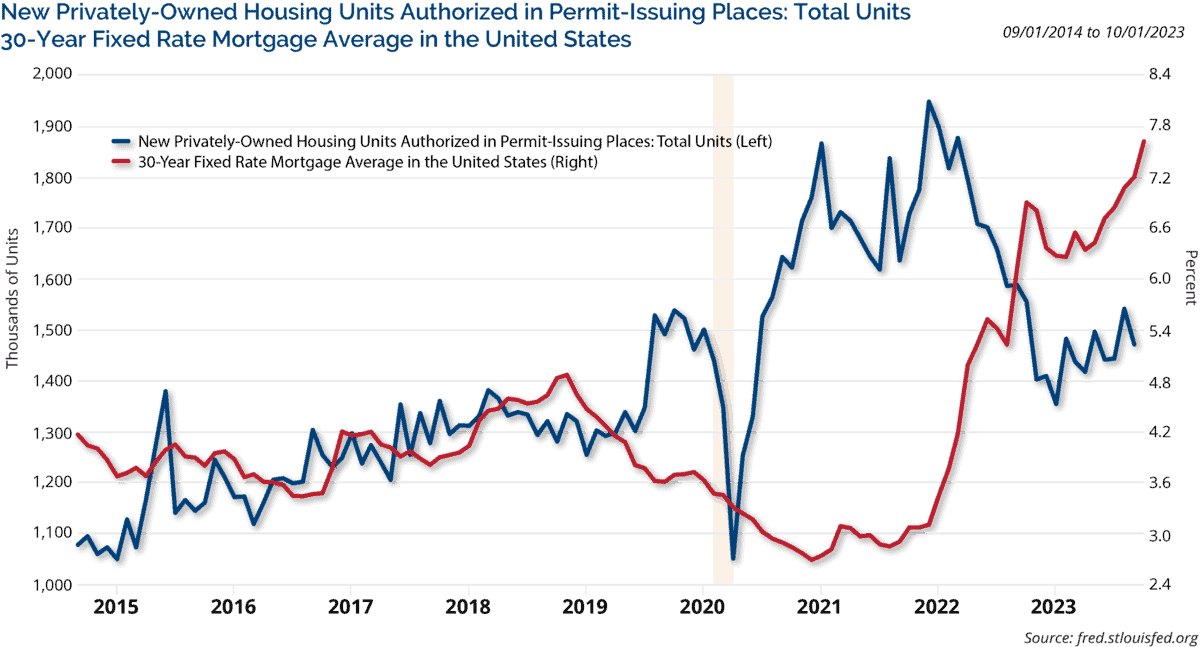 For illustrative purposes only. For illustrative purposes only. Past performance is not indicative of future results.
For illustrative purposes only. For illustrative purposes only. Past performance is not indicative of future results.The ISM Manufacturing Index for September made another move higher to 49.0, but it still signaled contraction for the 11th straight month. It was above estimates of 47.9 and the prior month of 47.6. However, the reading for October released on November 1 was disappointing at 46.7 when it was expected to stay at 49.0 and it marked contraction over the last year in manufacturing. The ISM Non-Manufacturing Index, which covers the much larger service industries in the U.S. economy, came in at 53.6 in September, a modest drop from the 54.5 reading last month, but it did beat expectations of 53.5. Strength from this important part of the economy is always encouraging. Recall, the dividing line between expansion and contraction for the ISM indices is 50.
Retail sales (ex. auto and gas) rose by a surprising 0.6% in September, when a modest 0.1% gain was expected. However, it is important to note that retail sales data is not inflation adjusted, so higher prices can appear to show more spending activity. The preliminary University of Michigan Sentiment reading for October dropped to 63.0 compared to expectations of 67.0 and the previous 68.1 level, which is not too surprising considering the weakness seen in the stock market over the last few months. The Conference Board’s Leading Index continued to decline and fell by -0.7% in September, which was worse than expectations of a -0.4% drop. For well over a year, the Leading Economic Index has been flashing a warning sign of pending economic weakness which has yet to materialize to any large degree.
The FOMC concluded a meeting on November 1 and as expected, declined to raise rates at this meeting. However, Chairman Powell continues to reiterate that the fight against inflation is not over and the idea of higher rates for longer seems to be the clear thinking of the Fed. As always, we believe it is imperative for investors to stay focused on their long-term goals and not let short-term swings in the market derail them from their longer-term objectives.
Investment Implications
Clark Capital’s Top-Down, Quantitative Strategies
Our tactical strategies entered the month of November with a risk-off bias, having turned defensive in early October. However, any meaningful strength and decline in yields could result in a pivot back to a risk-on bias.
Clark Capital’s Bottom-Up, Fundamental Strategies
Within fixed income, we continued to add shorter maturity issues that were yielding greater than 6.25% while also adding what we believe are higher quality 10-year bonds. This barbell approach should help to reduce portfolio volatility and overall interest rate risk, while still maintaining a high overall yield with appreciation potential should interest rates come in.
ECONOMIC DATA
| Event | Period | Estimate | Actual | Prior | Revised |
|---|---|---|---|---|---|
| ISM Manufacturing | Sept | 47.9 | 49.0 | 47.6 | — |
| ISM Services Index | Sept | 53.5 | 53.6 | 54.5 | — |
| Change in Nonfarm Payrolls | Sept | 170k | 336k | 187k | 227k |
| Unemployment Rate | Sept | 3.70% | 3.80% | 3.80% | — |
| Average Hourly Earnings YoY | Sept | 4.30% | 4.20% | 4.30% | — |
| JOLTS Job Openings | Sept | 9400k | 9553k | 9610k | 9497k |
| PPI Final Demand MoM | Sept | 0.30% | 0.50% | 0.70% | — |
| PPI Final Demand YoY | Sept | 1.60% | 2.20% | 1.60% | 2.00% |
| PPI Ex Food and Energy MoM | Sept | 0.20% | 0.30% | 0.20% | — |
| PPI Ex Food and Energy YoY | Sept | 2.30% | 2.70% | 2.20% | 2.50% |
| CPI MoM | Sept | 0.30% | 0.40% | 0.60% | — |
| CPI YoY | Sept | 3.60% | 3.70% | 3.70% | — |
| CPI Ex Food and Energy MoM | Sept | 0.30% | 0.30% | 0.30% | — |
| CPI Ex Food and Energy YoY | Sept | 4.10% | 4.10% | 4.30% | — |
| Retail Sales Ex Auto and Gas | Sept | 0.10% | 0.60% | 0.20% | 0.30% |
| Industrial Production MoM | Sept | 0.00% | 0.30% | 0.40% | 0.00% |
| Building Permits | Sept | 1453k | 1473k | 1543k | 1541k |
| Housing Starts | Sept | 1383k | 1358k | 1283k | 1269k |
| New Home Sales | Sept | 680k | 759k | 675k | 676k |
| Existing Home Sales | Sept | 3.89m | 3.96m | 4.04m | — |
| Leading Index | Sept | -0.40% | -0.70% | -0.40% | -0.50% |
| Durable Goods Orders | Sept P | 1.90% | 4.70% | 0.10% | -0.10% |
| GDP Annualized QoQ | 3Q A | 4.50% | 4.90% | 2.10% | — |
| U. of Mich. Sentiment | Oct P | 67 | 63 | 68.1 | — |
| Personal Income | Sept | 0.40% | 0.30% | 0.40% | — |
| Personal Spending | Sept | 0.50% | 0.70% | 0.40% | — |
| S&P CoreLogic CS 20-City YoY NSA | Aug | 1.75% | 2.16% | 0.13% | 0.15% |
Source: Bloomberg
Past performance is not indicative of future results. The opinions referenced are as of the date of publication and are subject to change due to changes in the market or economic conditions and may not necessarily come to pass. Material presented has been derived from sources considered to be reliable and has not been independently verified by us or our personnel. Nothing herein should be construed as a solicitation, recommendation or an offer to buy, sell or hold any securities, other investments or to adopt any investment strategy or strategies. Investors must make their own decisions based on their specific investment objectives and financial circumstances. Investing involves risk, including loss of principal.
Clark Capital Management Group is an investment adviser registered with the U.S. Securities and Exchange Commission. Registration does not imply a certain level of skill or training. More information about Clark Capital Management Group’s advisory services can be found in its Form ADV which is available upon request.
Fixed income securities are subject to certain risks including, but not limited to: interest rate (changes in interest rates may cause a decline in market value or an investment), credit, prepayment, call (some bonds allow the issuer to call a bond for redemption before it matures), and extension (principal repayments may not occur as quickly as anticipated, causing the expected maturity of a security to increase).
Clark Capital utilizes a proprietary investment model to assist with the construction of the strategy and to assist with making investment decisions. Investments selected using this process may perform differently than expected as a result of the factors used in the model, the weight placed on each factor, and changes from the factors’ historical trends. There is no guarantee that Clark Capital’s use of a model will result in effective investment decisions.
Non-investment-grade debt securities (high-yield/junk bonds) may be subject to greater market fluctuations, risk of default or loss of income and principal than higher-rated securities.
Foreign securities are more volatile, harder to price and less liquid than U.S. securities. They are subject to different accounting and regulatory standards and political and economic risks. These risks are enhanced in emerging market countries.
The value of investments, and the income from them, can go down as well as up and you may get back less than the amount invested.
Equity securities are subject to price fluctuation and possible loss of principal. Stock markets tend to move in cycles, with periods of rising prices and periods of falling prices. Certain investment strategies tend to increase the total risk of an investment (relative to the broader market). Strategies that concentrate their investments in limited sectors are more vulnerable to adverse market, economic, regulatory, political, or other developments affecting those sectors.
JOLTS is a monthly report by the Bureau of Labor Statistics (BLS) of the U.S. Department of Labor counting job vacancies and separations, including the number of workers voluntarily quitting employment.
The Producer Price Index (PPI) program measures the average change over time in the selling prices received by domestic producers for their output. The prices included in the PPI are from the first commercial transaction for many products and some services.
References to market or composite indices, benchmarks or other measures of relative market performance over a specified period of time (each, an “index”) are provided for your information only. Reference to an index does not imply that the portfolio will achieve returns, volatility or other results similar to that index. The composition of the index may not reflect the manner in which a portfolio is constructed in relation to expected or achieved returns, portfolio guidelines, restrictions, sectors, correlations, concentrations, volatility or tracking error targets, all of which are subject to change. Investors cannot invest directly in an index.
The Bloomberg Barclays U.S. Municipal Index covers the USD-denominated long-term tax exempt bond market. The index has four main sectors: state and local general obligation bonds, revenue bonds, insured bonds and prerefunded bonds.
The Bloomberg US Treasury Index measures US dollar-denominated, fixed-rate, nominal debt issued by the US Treasury. Treasury bills are excluded by the maturity constraint, but are part of a separate Short Treasury Index.
The Dow Jones Industrial Average indicates the value of 30 large, publicly owned companies based in the United States.
The NASDAQ Composite is a stock market index of the common stocks and similar securities listed on the NASDAQ stock market.
The S&P 500 measures the performance of the 500 leading companies in leading industries of the U.S. economy, capturing 80% of U.S. equities.
The S&P 500® Equal Weight Index (EWI) is the equal-weight version of the widely-used S&P 500. The index includes the same constituents as the capitalization weighted S&P 500, but each company in the S&P 500 EWI is allocated a fixed weight – or 0.2% of the index total at each quarterly rebalance.
The University of Michigan Consumer Sentiment Index rates the relative level of current and future economic conditions. There are two versions of this data released two weeks apart, preliminary and revised. The preliminary data tends to have a greater impact. The reading is compiled from a survey of around 500 consumers.
The Russell 1000 Growth Index measures the performance of the large-cap growth segment of the U.S. equity universe. It includes those Russell 1000 Index companies with higher price-to-book ratios and higher forecasted growth values.
The Russell 1000 Value Index measures the performance of the large-cap value segment of the U.S. equity universe. It includes those Russell 1000 Index companies with lower price-to-book ratios and lower forecasted growth values.
The Russell 2000 Index is a small-cap stock market index that represents the bottom 2,000 stocks in the Russell 3000.
The Russell 3000 Index measures the performance of the 3,000 largest U.S. companies based on total market capitalization, which represents approximately 98% of the investable U.S. equity market.
The 10 Year Treasury Rate is the yield received for investing in a US government issued treasury security that has a maturity of 10 year. The 10 year treasury yield is included on the longer end of the yield curve. Many analysts will use the 10 year yield as the “risk free” rate when valuing the markets or an individual security.
The Bloomberg Barclays U.S. Corporate High-Yield Index covers the U.S. dollar-denominated, non-investment grade, fixed-rate, taxable corporate bond market. Securities are classified as high-yield if the middle rating of Moody’s, Fitch, and S&P is Ba1/BB+/BB+ or below.
The Bloomberg Barclays U.S. Credit Index measures the investment grade, U.S. dollar denominated, fixed-rate taxable corporate and government related bond markets.
The Bloomberg Aggregate Bond Index or “the Agg” is a broad-based fixed-income index used by bond traders and the managers of mutual funds and exchange-traded funds (ETFs) as a benchmark to measure their relative performance.
The 30-Year Treasury is a U.S. Treasury debt obligation that has a maturity of 30 years. The 30-year Treasury used to be the bellwether U.S. bond but now most consider the 10-year Treasury to be the benchmark.
The ISM Non-Manufacturing Index is an index based on surveys of more than 400 non-manufacturing firms’ purchasing and supply executives, within 60 sectors across the nation, by the Institute of Supply Management (ISM). The ISM Non-Manufacturing Index tracks economic data, like the ISM Non-Manufacturing Business Activity Index. A composite diffusion index is created based on the data from these surveys, that monitors economic conditions of the nation.
ISM Manufacturing Index measures manufacturing activity based on a monthly survey, conducted by Institute for Supply Management (ISM), of purchasing managers at more than 300 manufacturing firms.
The MSCI Emerging Markets Index captures large and mid cap representation across 27 Emerging Markets (EM) countries.
The MSCI ACWI ex USA Index captures large and mid cap representation across 22 of 23 Developed Markets (DM) countries (excluding the US) and 27 Emerging Markets (EM) countries*. With 2,359 constituents, the index covers approximately 85% of the global equity opportunity set outside the US
The S&P CoreLogic Case-Shiller 20-City Composite Home Price NSA Index seeks to measures the value of residential real estate in 20 major U.S. metropolitan areas. The U.S. Treasury index is based on the recent auctions of U.S. Treasury bills. Occasionally it is based on the U.S. Treasury’s daily yield curve.
The Consumer Price Index (CPI) measures the change in prices paid by consumers for goods and services. The CPI reflects spending patterns for each of two population groups: all urban consumers and urban wage earners and clerical workers.
In the United States, the Core Personal Consumption Expenditure Price (CPE) Index provides a measure of the prices paid by people for domestic purchases of goods and services, excluding the prices of food and energy.
The VIX Index is a calculation designed to produce a measure of constant, 30-day expected volatility of the U.S. stock market, derived from real-time, mid-quote prices of S&P 500® Index (SPX℠) call and put options. On a global basis, it is one of the most recognized measures of volatility — widely reported by financial media and closely followed by a variety of market participants as a daily market indicator.
The Conference Board’s Leading Indexes are the key elements in an analytic system designed to signal peaks and troughs in the business cycle. The leading, coincident, and lagging economic indexes are essentially composite averages of several individual leading, coincident, or lagging indicators. They are constructed to summarize and reveal common turning point patterns in economic data in a clearer and more convincing manner than any individual component – primarily because they smooth out some of the volatility of individual components.
Gross domestic product (GDP) is the standard measure of the value added created through the production of goods and services in a country during a certain period.
Index returns include the reinvestment of income and dividends. The returns for these unmanaged indexes do not include any transaction costs, management fees or other costs. It is not possible to make an investment directly in any index.
CCM-993
